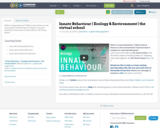
What is 'innate behaviour'? Where does it feature in the environment? And how does it compare to 'learned behaviour? Learn about it in this video by The Virtual School.
- Material Type:
- Diagram/Illustration
- Lecture
- Date Added:
- 02/22/2013

What is 'innate behaviour'? Where does it feature in the environment? And how does it compare to 'learned behaviour? Learn about it in this video by The Virtual School.

Learn how parental care is displayed by animals in their environment and how different species show parental care in different ways. As part of the Ecology topic from the Virtual School. Are you a passionate teacher who would like to reach hundreds of thousands of learners? Get in touch: vsteam@fusion-universal.com | Find out more: http://www.thevirtualschool.com | This video is distributed under a Creative Commons License: Attribution-NonCommercial-NoDerivs CC BY-NC-ND